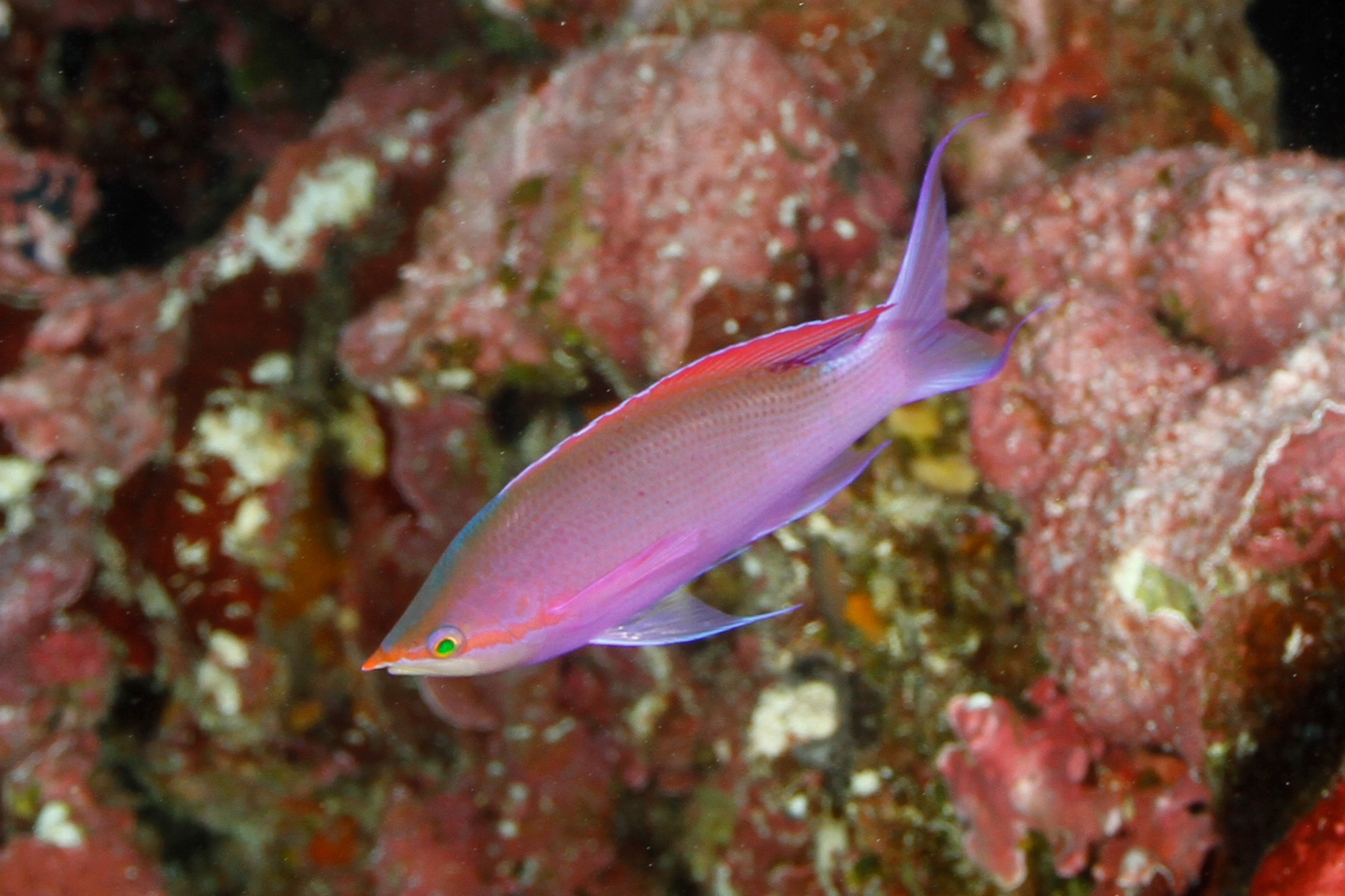Purple Queen, Mirolabrichthys tuka Herre & Montalban 1927
Other Names: Purple Anthias, Purple Queen-basslet, Purple Queenfish, Yellowstriped Fairy Basslet

A male Purple Queen, Pseudanthias tuka, on Osprey Reef in the Coral Sea, July 2015. Source: Ian Shaw / iNaturalist.org. License: CC BY Attribution-NonCommercial
Summary:
A deep pinkish to purple anthiine with a yellow stripe along the back and upper and lower caudal-fin lobes in females. Males have a very pointed snout, a dark blotch on the rear of the dorsal fin, extended caudal-fin lobes, and tall second dorsal and anal fin rays.
Cite this page as:
Bray, D.J. 2023, Mirolabrichthys tuka in Fishes of Australia, accessed 19 Apr 2024, https://fishesofaustralia.net.au/home/species/4403
Purple Queen, Mirolabrichthys tuka Herre & Montalban 1927
More Info
|
Distribution |
Offshore reefs of north Western Australia, Ashmore Reef in the Timor Sea, and the far northern Great Barrier Reef to northeast of Townsville, Queensland, and reefs in the Coral Sea. Elsewhere the species occurs in the south-east-Indo-west Pacific: Indonesia east to Philippines and Solomon Islands, north to southern Japan, south to Australia. Forms large aggregations along the upper edge of drop-offs and on steep outer reef slopes to depths of 40 m. |
|
Features |
Dorsal fin X,15-17; Anal fin III,7-8. |
|
Feeding |
Feeds on zooplankton in the water column. |
|
Biology |
A protogynous hermaphrodite with a dominant male and a harem of females and juveniles. |
|
Remarks |
This species has previously been known as Pseudanthias tuka. |
|
Similar Species |
Purple Queen males differ from males of the Sailfin Queen, Mirolabrichthys pascalus, in having a yellowish snout and chin. |
|
Etymology |
The specific name tuka (= beak) in the Tagalog language group in the Philippines, in allusion to the projecting tip on the snout. |
|
Species Citation |
Mirolabrichthys tuka Herre & Montalban, in Herre 1927, Philippine Journal of Science 32: 413. Type locality: Maricaban Island, Philippine Islands. |
|
Author |
Bray, D.J. 2023 |
|
Resources |
Purple Queen, Mirolabrichthys tuka Herre & Montalban 1927
References
Allen, G.R. 1997. Marine Fishes of Tropical Australia and South-east Asia. Perth : Western Australian Museum 292 pp. 106 pls. (as Pseudanthias tuka)
Allen, G.R. & Erdmann, M.V. 2012. Reef fishes of the East Indies. Perth : Tropical Reef Research 3 vols, 1260 pp. (as Pseudanthias tuka)
Allen, G.R. & Starck, W.A. 1982. The anthiid fishes of the Great Barrier Reef, Australia, with the description of a new species. Revue Française d'Aquariologie et Herpétologie 9(2): 47-56 figs 1-28 (as Anthias tuka)
Gill, A.C. 2022. Revised definitions of the anthiadine fish genera Mirolabrichthys Herre and Nemanthias Smith, with description of a new genus (Teleostei: Serranidae). Zootaxa 5092(1): 041-066. https://doi.org/10.11646/zootaxa.5092.1.2
Herre, A.W. & Montalban, H.R. in Herre, A.W. 1927. A new genus and three new species of Philippine fishes. Philippine Journal of Science 32: 413-417 figs 1-2
Hutchins, J.B. 2001. Biodiversity of shallow reef fish assemblages in Western Australia using a rapid censusing technique. Records of the Western Australian Museum 20: 247-270 (as Pseudanthias tuka)
Kuiter, R.H. 1996. Guide to Sea Fishes of Australia. A comprehensive reference for divers and fishermen. Sydney, NSW, Australia : New Holland Publishers xvii, 434 pp. (as Pseudanthias tuka)
Kuiter, R.H. 2004. Basslets, Hamlets and their relatives. A comprehensive guide to selected Serranidae and Plesiopidae. Chorleywood, UK : TMC Publishing 1, 216 pp. (as Pseudanthias tuka)
Randall, J.E., Allen, G.R. & Steene, R. 1997. Fishes of the Great Barrier Reef and Coral Sea. Bathurst : Crawford House Press 557 pp. figs. (as Pseudanthias tuka)
Williams, J.T., Lawrence, A. & Myers, R. 2016. Pseudanthias tuka. The IUCN Red List of Threatened Species 2016: e.T69591878A69592819. https://dx.doi.org/10.2305/IUCN.UK.2016-3.RLTS.T69591878A69592819.en. Downloaded on 07 November 2020.









